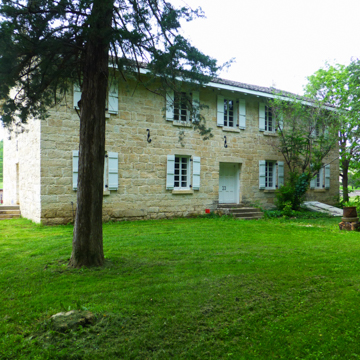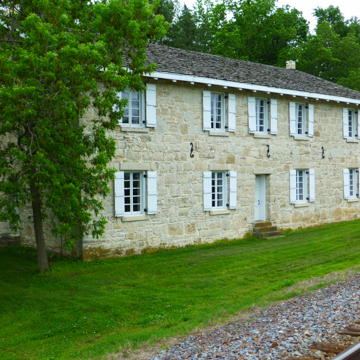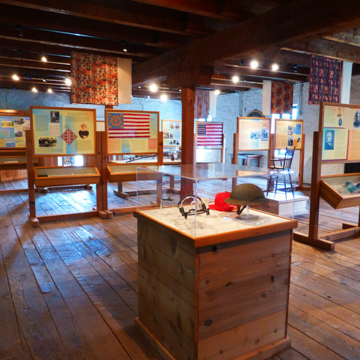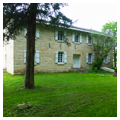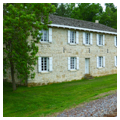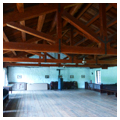The First Territorial Capitol is a simple but elegant vernacular limestone structure built in the spring of 1855 to house the initial meeting of the Kansas territorial legislature. It is important as a symbol of the discord and controversy of the territorial era, particularly whether or not Kansas would be admitted as a slave state. It also reveals the ways that personal interests could sometimes intersect with larger and more fundamental concerns.
The two-story, rectangular building measures approximately 40 x 80 feet. The walls are made of limestone quarried from a bluff to the north of the building. The north, east, and west walls are made of roughly coursed rubble stone, while the south wall, which faces toward the Kansas River several hundred yards away, is made of carefully shaped stone laid in regular horizontal coursing. A door is centered on each elevation, a chimney is located on the center of the east and west facades, and four regularly spaced windows are on the north and south facades. The simple, gabled roof is clad with wooden shingles, with the gable running east to west. The building contains a single, large room on each floor. The lower level, which served as the House chamber, is divided down the center in the east-west direction by a row of wooden columns. The upper floor, which is accessible by an interior stair, housed the Senate chamber. Heavy wood trusses span this space, creating a single, large, unencumbered room.
In 1854, soon after he was appointed as the first Territorial Governor of Kansas, Andrew H. Reeder established the location of the First Territorial Capitol on the eastern edge of Fort Riley, the central military outpost on the territory’s western frontier in an area that he hoped would become the town of Pawnee. Reeder enlisted Major William Montgomery, the newly assigned post commander of Fort Riley, to assist him in the development of the town. Montgomery, in turn, assured territorial officials that it would be advantageous for the fort to have a civilian outpost nearby to support its commercial needs. To oversee the development of the town, the Pawnee Town Association was established, consisting of eight ranking officers from the fort, including Montgomery, who was president of the board, and twelve prominent Kansas citizens, including Governor Reeder, who requested a sizeable area of the town be gifted to him. Other board members could purchase lots at a discount and resell them for a considerable profit. Within the 320-acre town site, the First Territorial Capitol building was among the first to be built in Pawnee.
Governor Reeder called the territorial legislature into session at the newly built capitol on July 1, 1855. The majority of legislators were pro-slavery advocates from Kansas’s easternmost communities. These legislators managed to remove many of the anti-slavery, or free-state delegates. On July 4, they passed a law moving the Territorial Capitol to Shawnee Mission, which would be more convenient to legislators from eastern Kansas. Two days later, Governor Reeder vetoed the bill, and the legislators promptly overthrew the veto, adjourned the session, and agreed to meet again ten days later in the facilities of the Shawnee Methodist Mission.
Although the First Territorial Capitol was used for its intended purpose for only five days, the building witnessed a pivotal moment in the Kansas Territory, and indeed for the United States. Over the next six years, the territorial legislature would meet in three other locations and produce four proposed constitutions, two that would have allowed slavery in Kansas and two that would have forbidden it. These were years of turmoil and considerable bloodshed as pro-slavery and free-state advocates jockeyed for dominance. In the end, the issue was settled by public vote. An overwhelming majority rejected slavery, and in 1861 Kansas entered the United States as a free state.
Meanwhile, when a plat of Fort Riley was sent to Washington for approval, the government discovered the use of federal land for private ownership. By the end of 1855, Andrew Reeder was dismissed as governor, Major Montgomery was court-martialed, settlers in Pawnee were evicted, and all traces of the settlement except the Territorial Capitol were removed.
The capitol building was used by the army in various ways through the years. Among other things, it served as a storehouse and a dormitory. In 1882 a storm blew off the roof, and the building began to deteriorate. In 1928, the Union Pacific Railroad, whose tracks pass within a few yards of the north side of the First Territorial Capitol, restored the building. A local group, the Partners of the First Territorial Capitol, now operates the building as a museum and meeting space.
References
Childs, Gaylynn. The Five-Day Capitol: A Brief History of the First Territorial Capitol of Kansas. Partners of the First Territorial Capitol of Kansas, 2004.
Federal Writers Project of the Works Projects Administration for the State of Kansas. WPA Guide to 1930s Kansas. Lawrence: University Press of Kansas, 1984.
McKale, William, and William D. Young. Fort Riley: Citadel of the Frontier West. Topeka: Kansas State Historical Society, 2000.
Pankratz, Richard, “First Territorial Capitol,” Geary County, Kansas. National Register of Historic Places Inventory-Nomination Form, 1970. National Park Service, U.S. Department of the Interior, Washington, D.C.

